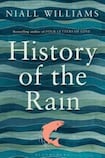
'The rain it raineth every day," sings Feste in Twelfth Night , and nowhere is this more true than in the village of Faha, in deep west Co Clare, where Niall Williams's elaborate skein of yarning is set.
The Shannon winds up in the fields for good measure. But locals seem untouched by it. The rain is their medium, melding the earth and the air around them, making the going dodgy underfoot, and supplying a steady trickle of metaphors about life’s slipperiness, haziness, and the need to keep head above water no matter what, even (or especially) when the whole country seems sunk under the blunders of the bust.
Such figures of speech occur now and then as a matter of course to the narrator, Ruth Swain, and no wonder: she’s a writer. Indeed, she’s a kind of Proustian, even if Proust is not one of the many great authors she calls on as witness, guide, inspiration and companion. Bedridden with a blood disorder, she spends her days in a garret room insulated by 3,958 books, filling Aisling copybooks in the hope of getting to the bottom of her late father’s nature. Virgil was his name (middle name Feste), a poet. A failed poet, a failed farmer, a failed everything, though to Ruth all the more fascinating and endearing for the world being too much with him.
Family saga In one way History of the Rain is a family saga. With many a meander, quotation, vignette and reminiscence, Ruth navigates the history of the Swains. "This, Dear Reader, is a river narrative," and its current is sometimes swift, sometimes sluggish; there's heavy undertow, calm stretches, dangerous pools, backwaters – yes, more metaphors to buoy the reader up.
Virgil comes from a long line of English clergy that his father breaks by settling in Co Meath. His main achievement is to publish anonymously a work called The Salmon in Ireland . There's a strain of the salmon in the Swains, father and son. They go against the current, leaping into an element not their own is part of their nature, and they allow themselves to become hooked.
The salmon in Irish myth is also invoked, one of the novel’s many affirmations of the existence of two worlds, the one we inhabit and the one to which we aspire. (Ruth thinks of herself “between this world and the next”.)
After a career away at sea – and he does seem at sea a fair amount of the time – Virgil fetches up on the banks of the Shannon, where Mary McCarroll of Faha falls for him. Her family goes back to before the Flood – had their origins as seaweed, we’re told. Mary and her mother keep the household going.
Virgil is useless at applying himself to the world, but he's a great hand at submerging himself in it. What land, river, light and air contain continually wash over him. In time he starts to write poetry. It's no good either. But what counts is the aspiration, the keeping hope alive, the great desire that not everything be a washout, even when the manuscript entitled History of the Rain is lost. Virgil is only a letter from being virgin. And his daughter is closer than that.
So far so fair enough. As the story of an unconventional father, a mixed marriage, a small place and a distinct landscape, History of the Rain is readable and diverting enough. Ruth's throwaway remarks about the very many locals of her acquaintance are spot-on in tone and tenor, and although her comments on the boom and the bust amount to little more than shooting fish in a barrel her aim is true as far as it goes.
That's not all there is to History of the Rain , though. Ruth is not just an invalid and chronicler. She's also an evangelist of literature. She's a great fan of the Victorians, and they all get their due here, none more so than Dickens, the daddy of them all. (Edna O'Brien, John Banville and Anne Enright make brief appearances, too.)
Minor characters are recalled, as are, more interestingly, textures and colourings, these perhaps compensating Ruth for the sensual life she can no longer enjoy as well as helping her to get a feel for her father’s absorption in the elemental world.
Moby Dick But her habit of fortifying her story with citations from the great novelists wears thin. Some of the allusions fail to convince: attaching her mariner father to Moby Dick, for instance, or the claim that "there was some profound affinity between the Deep South, Latin America, and the County Clare". It might be that Faha is the second coming of Gabriel García Márquez's Macondo, and west Co Clare is Faulkner's Yoknapatawpha resurrected. Saying it doesn't make it so, though.
Added to these literary prostheses are Ruth’s pronouncements on stories – “we tell stories to heal the pain of living”, and so on. That may be true for the stories we tell ourselves and among ourselves. But the notion of literature as therapy is not one many writers share, I’d say, not even those who think that “writing of course is a kind of sickness”. And as for the claim that “the country was moving into a time when only story would sustain it”, well, seen in a less aspirational light, that could be one version of the problem.
Ruth is hoping to heal herself in her reading and writing, and the best of luck to her. In that hope there's remarkable innocence. And she shares that quality with her fellow-Fahaites. So much harmlessness, charm and good neighbourliness should be cheering, especially as it seems intended for a dark time. Instead, maybe just because it is so saturated in good intentions, History of the Rain feels, well, a bit wet.
George O’Brien’s The Irish Novel 1960-2010 has recently appeared in paperback.









